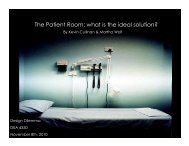The role of physical design and informal communication
The role of physical design and informal communication
The role of physical design and informal communication
Create successful ePaper yourself
Turn your PDF publications into a flip-book with our unique Google optimized e-Paper software.
Table 4 Overall percent & frequency <strong>of</strong> who the GN interacted with <strong>and</strong> average<br />
frequency per 8-hour shift<br />
Person Percent Frequency Frequency/8hr<br />
Work Alone 35.2% 571 184<br />
Patient 20.4% 332 107<br />
Visitor 3.9% 64 21<br />
Nurse 14.7% 238 77<br />
Doctor 2.6% 42 14<br />
Allied Health 7.2% 117 38<br />
Orientor 13.9% 225 72<br />
GN 2.2% 35 11<br />
Frequency/8hr<br />
200<br />
180<br />
160<br />
140<br />
120<br />
100<br />
80<br />
60<br />
40<br />
20<br />
0<br />
Work<br />
Alone<br />
Patient Visitor Nurse Doctor Allied<br />
Health<br />
Person<br />
Orientor GN<br />
Figure 23 Average frequency per 8-hour shift <strong>of</strong> who the GN interacted with<br />
Table 5 shows the frequency <strong>of</strong> who the GN interacted with in each <strong>of</strong> the<br />
eight weeks, <strong>and</strong> it illustrates how the interaction patterns <strong>of</strong> the GN changed over<br />
time. Similar to the task data, most patterns are not distinct. However, as Figure 24<br />
illustrates, frequency <strong>of</strong> interaction with visitors <strong>and</strong> with the patient increased over<br />
74







